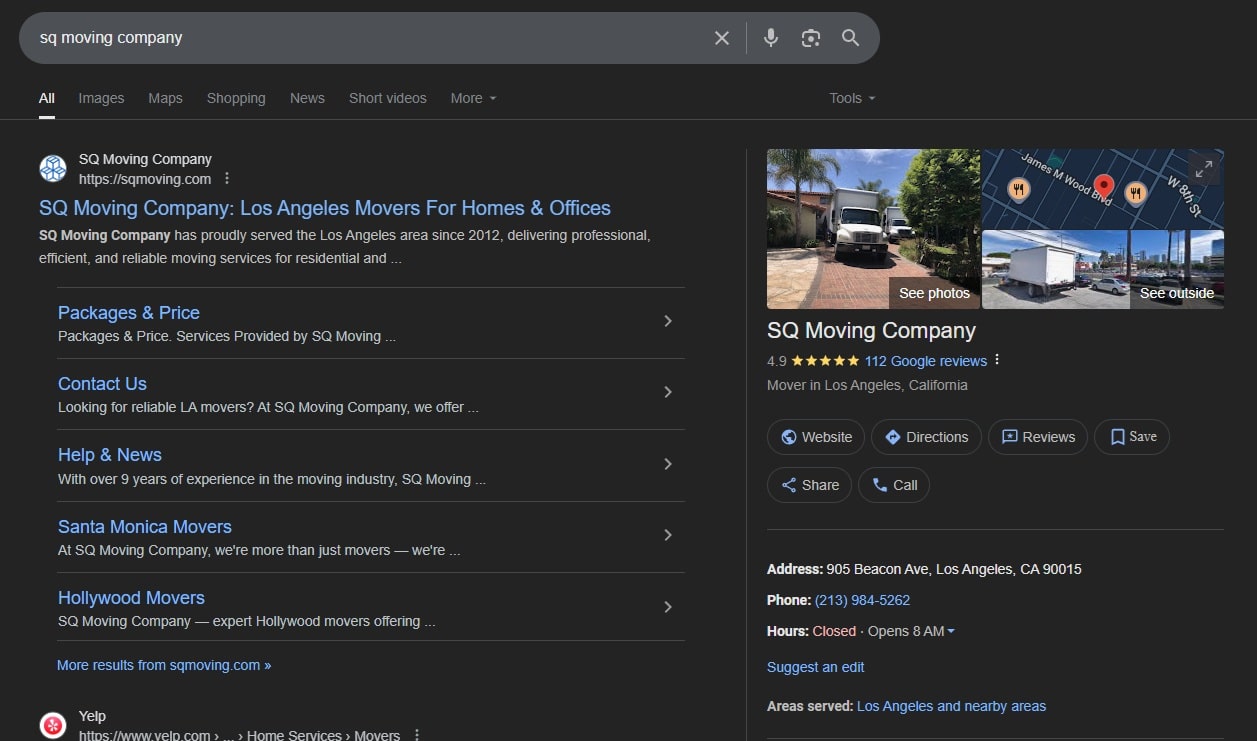In today’s world, most of us wouldn’t even think about hiring a company without first checking their reviews. Whether it’s on Google, Yelp, or Facebook, online reviews have become the modern version of “word of mouth.” But here’s the problem: not every review is genuine. Some are written by real customers sharing honest feedback, but others are carefully crafted fakes — either to boost a company’s image or to harm a competitor.
If you’ve ever wondered how to recognize fake reviews, this guide will walk you through the most common signs, the tricks companies use, and how to protect yourself from being misled. We’ll even share a real-life example of how SQ Moving Company was targeted by a fake review attack in August 2025 — and how Google handled it.
Why Fake Reviews Are a Growing Problem
The online review space has become a powerful marketing tool, and unfortunately, that power attracts abuse. According to consumer watchdog reports, fake review activity increased in 2024 and shows no signs of slowing in 2025. The incentives are clear:
-
Boost reputation instantly: A flood of glowing 5-star reviews can push a company higher in search results.
-
Damage competitors: Posting fake negative reviews can quickly scare potential customers away.
-
Manipulate trust: Reviews are one of the most trusted forms of online content, making them an easy way to influence decisions.
For industries like moving, where trust is everything, spotting fake vs real reviews is more important than ever.
Fake reviews can mislead you into hiring unreliable movers. To avoid this, take the next step by reading our guide on How to Choose the Right Moving Company for Your Upcoming Move
The Most Common Fake Review Tactics in 2025
1. Forced Positive Reviews
Some moving companies have taken “review requests” to an extreme. It’s not unusual for them to:
-
Ask customers to write a positive review with a picture before the job is even finished.
-
Offer small discounts or perks in exchange for a 5-star rating.
If you see a suspiciously high percentage of reviews with similar-looking photos or overly polished language, there’s a good chance they’re not 100% authentic.
2. Paid Review Agencies
There are agencies that specialize in creating fake reviews — both positive for paying clients and negative for competitors.
These agencies often:
-
Create multiple fake accounts.
-
Post reviews from different cities, states, or even countries in a short time frame.
-
Use generic, copy-paste text.
3. Fake Negative Review Attacks
Not all fake reviews are positive. In fact, some of the most damaging attacks involve a sudden flood of fake 1-star ratings.
Our real experience:
In end of July 2025, SQ Moving Company was targeted in a massive fake negative review attack. We received a message from someone on Facebook who admitted they had been hired to post dozens of bad reviews on our profile — and demanded payment to stop. When we refused, they posted 56 negative reviews in just one hour.
Thankfully, after we reported the incident and provided proof, Google removed all fake reviews by the next day. But for those 24 hours, our rating dropped sharply, and it could have scared potential customers away if they didn’t know the full story.
How to Recognize Fake Reviews
Spotting fake reviews isn’t always easy, but there are clear signs that can help you identify them.
1. Generic or Overly Vague Language
Real customers tend to include specific details about their experience. Fake reviews often sound like:
-
“They are the best movers ever!”
-
“Worst company ever, don’t hire them.”
No details about dates, names, or actual events usually means low credibility.
2. Extreme Positivity or Negativity
Authentic reviews often have a mix of pros and cons. If all the reviews are too perfect or too awful, that’s a red flag.
-
Fake positive reviews tend to be overly flattering, with lots of exclamation marks.
-
Fake negative reviews may sound more like personal attacks than genuine complaints.
3. Repetitive Phrases and Patterns
If multiple reviews use the exact same phrases — like “fast, affordable, best movers in town” — it might be a sign that they’re written by the same source.
Looking for the best neighborhood in LA to live? Check out our Top 10 Neighborhoods to Move to in Los Angeles (2025 Guide) for insider tips, local highlights, and moving advice.
4. Suspicious Reviewer Profiles
Fake reviewers often have online profiles that raise red flags. Common signs include:
-
No profile picture or a generic placeholder image.
-
Only one review ever posted on their account.
-
A history of reviews for unrelated businesses in different states or countries, often within a short timeframe.
-
Weird or unnatural profile names, such as random combinations of letters and numbers, or overly generic names that seem fake (e.g., “John Smith 789”).
When you see one or more of these signs, it’s worth questioning the authenticity of the review.
5. Timing Clusters
A sudden spike in reviews — whether positive or negative — within a short period is worth questioning. Real customer feedback usually comes in gradually over time.
One quick way to assess authenticity is to check when the company was established and compare that with the total number of reviews. For example, if a moving company has only been operating for two years, has a small fleet of a few trucks, yet has over 500 glowing reviews, the numbers may not add up.
Industry statistics show that:
-
If a company actively follows up (sending customers an email or text after the job with a direct Google review link), about 1 in 20 customers will actually leave a review.
-
If a company doesn’t ask at all, the number drops to around 1 in 100.
So, if you see a business collecting reviews every single day — sometimes multiple in one day — and the volume seems far beyond what’s realistic for their size, there’s a strong chance at least some of them could be fake.
6. Overuse of Photos
While genuine customers may post a picture or two, fake reviews sometimes overcompensate by attaching a photo to almost every review to make them look authentic. If a business has 90%+ reviews with similar-looking images, it’s suspicious.
Ask yourself: Do you personally leave a review with a related picture every time you share feedback? Most people don’t — which is why an unusually high percentage of photo reviews can be a red flag.
How to Identify Fake Google Reviews Specifically
Google has become better at spotting fraudulent activity, but some slip through. To identify fake Google reviews:
-
Look for profiles with no local presence.
-
Check their review history for unrelated industries.
-
Watch for identical reviews posted on multiple businesses’ pages.
Fake vs Real Reviews: A Quick Comparison
When checking reviews for relocation services in Los Angeles, here are some quick ways to spot the difference between genuine feedback and suspicious ones:
-
Signs of a Real Review: Often include specific names, dates, and service details. They provide balanced feedback, pointing out both pros and cons of the experience. Real reviews are posted gradually over time and usually come from profiles that show varied, local activity. They may also include photos that feel natural and varied.
-
Signs of a Fake Review: Typically contain vague, generic praise or criticism with no real details. They tend to be extreme — either all good or all bad — with no nuance. Fake reviews often appear in clusters, with dozens posted within hours or days. The reviewer’s profile may have no history or only unrelated activity, and the photos attached often look stock-like or overly staged.
What to Do If You Suspect a Fake Review
For Customers
-
Don’t rely on one review — look for patterns over time.
-
Cross-check with other platforms (Yelp, BBB, Facebook).
-
Ask the company questions directly to verify service details.
-
Remember: A negative review doesn’t always mean the company did something wrong. Sometimes customers try to take advantage by demanding discounts and then posting a bad review if they don’t get them. Other times, a small misunderstanding can lead an overemotional customer to leave a harsh 1-star rating.
-
Always read the business’s response to a review — this can give you valuable context and help you see both sides of the story.
-
Don’t hesitate to contact the business directly to share your concerns about hiring them or to ask about a specific negative review. A reputable company will usually be happy to clarify and explain the situation.
For Business Owners
-
Document suspicious reviews with screenshots.
-
Report them through the platform’s review dispute process.
-
Avoid responding emotionally — keep your reply professional.
-
Continue encouraging real customers to leave honest feedback.
How SQ Moving Company Handles Reviews
At SQ Moving Company, we believe in transparency and honesty. We never pay for reviews or offer discounts in exchange for positive feedback. Every review — good or bad — comes from a real customer.
If you’d like to see what genuine reviews look like, check out our Customer Reviews page. You can also learn more about our values and approach to moving services on our blog page.
Final Thoughts
Fake reviews aren’t going away anytime soon, but by learning how to recognize fake reviews and spot the red flags, you can make better choices and protect yourself from misleading information.
Whether you’re hiring movers, finding a restaurant, or booking a hotel, remember: patterns tell the real story. If something feels off, trust your instincts — and do a little extra research.
If you want a moving company with a proven record of honest service and genuine customer feedback, contact SQ Moving Company today for a free quote.
If you’re currently researching movers, this topic could be interesting for you: How to Choose the Best Moving Professionals in Los Angeles.






















